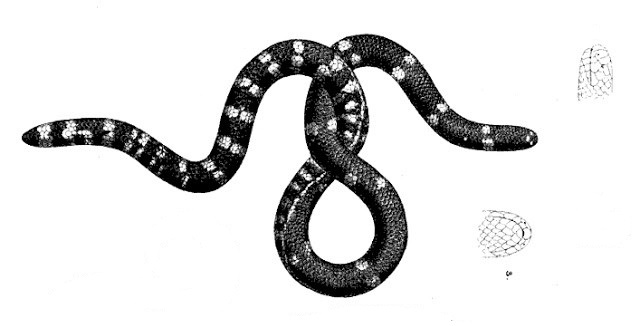Superregnum: Eukaryota
Regnum: Animalia
Subregnum: Eumetazoa
Cladus: Bilateria
Cladus: Nephrozoa
Superphylum: Deuterostomia
Phylum: Chordata
Cladus: Craniata
Subphylum: Vertebrata
Infraphylum: Gnathostomata
Superclassis: Tetrapoda
Cladus: Reptiliomorpha
Cladus: Amniota
Classis: Reptilia
Cladus: Eureptilia
Cladus: Romeriida
Subclassis: Diapsida
Cladus: Sauria
Infraclassis: Lepidosauromorpha
Superordo: Lepidosauria
Ordo: Squamata
Subordo: Serpentes
Superfamilia: Booidea
Familia: Anomochilidae
Genus: Anomochilus
Species: Anomochilus weberi
Name
Anomochilus weberi (Lidth de Jeude, 1890)
References
Links
Uetz, P. & Hallermann, J. 2021. Anomochilus weberi. The Reptile Database. Accessed on 1 November 2019.
Das, I. 2012. IUCN: Anomochilus weberi (Data Deficient). The IUCN Red List of Threatened Species 2012: e.T192155A2048153. DOI: 10.2305/IUCN.UK.2012-1.RLTS.T192155A2048153.en
Vernacular names
English: Sumatran Giant Blind Snake
Anomochilus weberi, commonly known as Weber's pipe snake[3] or the Sumatran giant blind snake,[1] is a species of snake in the family Anomochilidae. The species is endemic to Southeast Asia and Oceania.
Etymology
The specific name, weberi, is in honor of German-Dutch zoologist Max Wilhelm Carl Weber van Bosse.[4]
Geographic range
A. weberi is found in Indonesia, where it is known from Sumatra and Borneo, and in Malaysia, where it is known from Sabah.[1][2][5]
Habitat
The preferred natural habitat of A. weberi is forest, at altitudes of 300–1,000 m (980–3,280 ft).[1]
Description
A. weberi has the following scalation: frontal quadrangular, nearly twice as large as the supraocular; no enlarged parietals; four upper labials, third largest and in contact with eye; dorsal scales in 21 rows; ventrals 244, scarcely larger than dorsal scales; anal divided; subcaudals 8. Dorsally, it is brown, with each scale edge lighter. There is a light spot on each prefontal and on the frontal. On each side of the back there is a series of round light spots, in pairs or alternating. Along the middle of each side there is an interrupted whitish line. Ventrally it has irregular light spots arranged in pairs and sometimes confluent.[6]
References
Das I (2012). "Anomochilus weberi ". IUCN Red List of Threatened Species. 2012: e.T192155A2048153. doi:10.2305/IUCN.UK.2012-1.RLTS.T192155A2048153.en.
Anomochilus weberi at the Reptarium.cz Reptile Database. Accessed 19 December 2015.
"Anomochilus weberi Weber's Pipe Snake". Encyclopedia of Life. Retrieved 19 December 2015.
Beolens, Bo; Watkins, Michael; Grayson, Michael (2011). The Eponym Dictionary of Reptiles. Baltimore: Johns Hopkins University Press. xiii + 296 pp. ISBN 978-1-4214-0135-5. (Anomochilus weberi, p. 280).
Das I, Lakim M, Lim KKP, Hui TH (2008). "New species of Anomochilus from Borneo (Squamata: Anomochilidae)" (PDF). Journal of Herpetology. 42 (3): 584–591. doi:10.1670/07-154.1. JSTOR 40060554. S2CID 85684485.
Boulenger GA (1893). Catalogue of the Snakes in the British Museum (Natural History), Volume I., Containing the Families ... Ilysiidæ ... London: Trustees of the British Museum (Natural History). (Taylor and Francis, printers). xiii + 448 pp. + Plates I-XXVIII. (Anomalochilus weberi, p. 134).
Further reading
Lidth de Jeude TW van (1890). "REPTILIA from the Malay Archipelago. II. Ophidia". pp. 178–192. (Anomalochilus weberi, new species, p. 181 + Plate XV, figures 1-3). (in English). In: Weber M (1890). Zoologische Ergebnisse einer Reise in Niederländisch Ost-Indien. Erster Band [ Volume I ]. Leiden: E.J. Brill. xi + 3 maps + 460 pp. + Plates I-XXV. (in German, French, and English).
Retrieved from "http://en.wikipedia.org/"
All text is available under the terms of the GNU Free Documentation License


